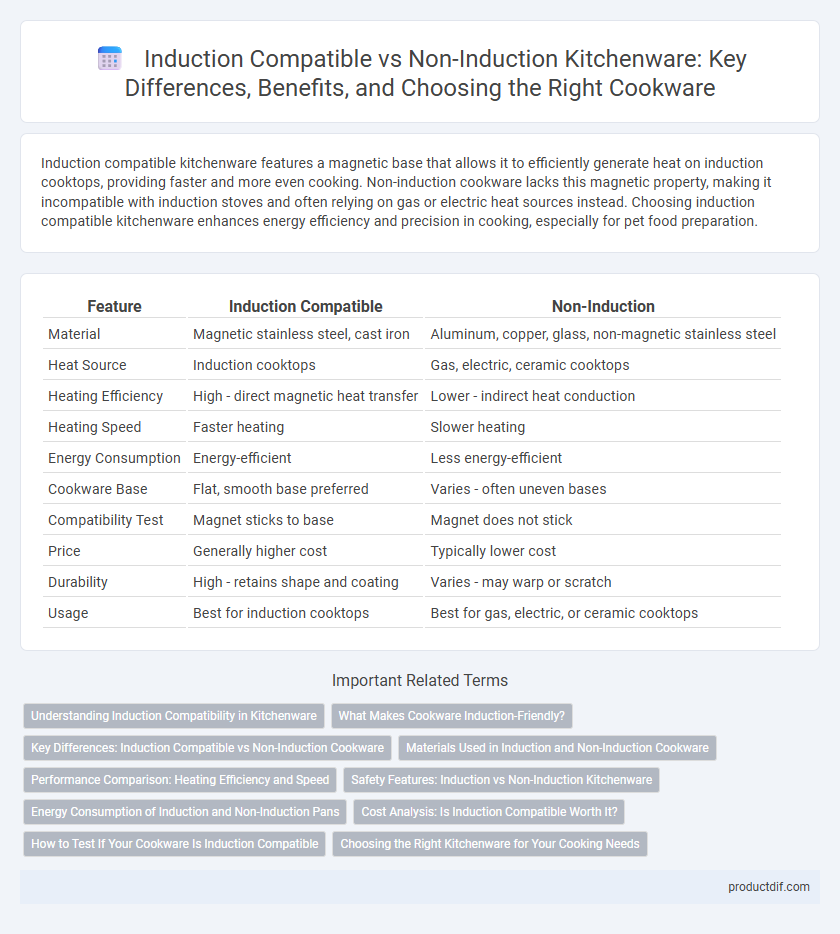Induction compatible kitchenware features a magnetic base that allows it to efficiently generate heat on induction cooktops, providing faster and more even cooking. Non-induction cookware lacks this magnetic property, making it incompatible with induction stoves and often relying on gas or electric heat sources instead. Choosing induction compatible kitchenware enhances energy efficiency and precision in cooking, especially for pet food preparation.
Table of Comparison
| Feature | Induction Compatible | Non-Induction |
|---|---|---|
| Material | Magnetic stainless steel, cast iron | Aluminum, copper, glass, non-magnetic stainless steel |
| Heat Source | Induction cooktops | Gas, electric, ceramic cooktops |
| Heating Efficiency | High - direct magnetic heat transfer | Lower - indirect heat conduction |
| Heating Speed | Faster heating | Slower heating |
| Energy Consumption | Energy-efficient | Less energy-efficient |
| Cookware Base | Flat, smooth base preferred | Varies - often uneven bases |
| Compatibility Test | Magnet sticks to base | Magnet does not stick |
| Price | Generally higher cost | Typically lower cost |
| Durability | High - retains shape and coating | Varies - may warp or scratch |
| Usage | Best for induction cooktops | Best for gas, electric, or ceramic cooktops |
Understanding Induction Compatibility in Kitchenware
Induction-compatible kitchenware contains ferromagnetic materials like cast iron or stainless steel that enable magnetic fields to generate heat directly within the cookware. Non-induction cookware, typically made from aluminum, copper, or glass, lacks this magnetic property and cannot heat effectively on induction cooktops. Understanding the magnetic base requirement and cookware material ensures efficient cooking performance and energy savings on induction stovetops.
What Makes Cookware Induction-Friendly?
Induction-compatible cookware features a magnetic base made of ferrous metals such as cast iron or stainless steel, enabling it to generate heat through electromagnetic induction. Non-induction cookware lacks this magnetic property, often made from materials like aluminum or copper, which are poor conductors of the induction cooktops' electromagnetic field. The key factor that makes cookware induction-friendly is its ability to maintain contact with the magnetic field, creating an efficient heat source directly on the cooking surface.
Key Differences: Induction Compatible vs Non-Induction Cookware
Induction compatible cookware contains magnetic materials such as cast iron or stainless steel with a magnetic base, enabling efficient heat transfer on induction cooktops. Non-induction cookware, often made from copper, aluminum, or glass, lacks magnetic properties and cannot generate heat on induction stoves without an additional induction interface disk. Understanding the cookware's material composition and base magnetic compatibility is essential for selecting optimal kitchenware for induction cooking technology.
Materials Used in Induction and Non-Induction Cookware
Induction compatible cookware is primarily made from ferromagnetic materials such as cast iron, stainless steel with magnetic properties, and enamel-coated steel, which enable efficient heat transfer through electromagnetic induction. Non-induction cookware often uses materials like aluminum, copper, and glass, which lack magnetic properties and therefore cannot generate heat on induction cooktops without an added magnetic layer. Cookware construction sometimes combines layers, such as an aluminum core with a magnetic stainless steel outer layer, to provide induction compatibility while maintaining heat conduction benefits.
Performance Comparison: Heating Efficiency and Speed
Induction-compatible cookware features a magnetic base that enables rapid and even heating by directly interacting with induction cooktops, resulting in superior energy efficiency and faster cooking times compared to non-induction cookware. Non-induction pots and pans rely on thermal conduction from electric or gas elements, often leading to slower heat-up periods and uneven temperature distribution. The performance gap in heating speed and efficiency makes induction-compatible kitchenware ideal for precision cooking and energy savings.
Safety Features: Induction vs Non-Induction Kitchenware
Induction-compatible kitchenware is designed with magnetic materials like stainless steel or cast iron, ensuring secure heat transfer and preventing overheating, which enhances safety during cooking. Non-induction cookware, often made from copper or aluminum, lacks magnetic properties and can cause uneven heating, increasing the risk of burns or fire hazards. Induction technology also automatically shuts off when cookware is removed, adding an extra layer of safety not found in non-induction kitchenware.
Energy Consumption of Induction and Non-Induction Pans
Induction-compatible pans use electromagnetic energy to directly heat cookware, resulting in approximately 20-30% higher energy efficiency compared to non-induction pans, which rely on gas or electric heating elements that lose heat to the surrounding air. Non-induction pans typically consume more energy due to indirect heat transfer and longer cooking times, leading to greater overall energy wastage. The precise heat control of induction technology reduces energy consumption by minimizing heat loss and improving cooking speed.
Cost Analysis: Is Induction Compatible Worth It?
Induction compatible cookware often comes with a higher upfront cost due to the specialized magnetic materials required for efficient heat transfer on induction cooktops, while non-induction cookware generally remains more affordable. Over time, induction cookware can offer energy savings and faster cooking times, potentially offsetting the initial investment. Consumers should weigh the long-term energy efficiency and durability of induction-compatible kitchenware against their budget constraints and cooking habits.
How to Test If Your Cookware Is Induction Compatible
To test if your cookware is induction compatible, place a magnet on the base of the pan; if it sticks firmly, the cookware works with induction cooktops. Induction-compatible cookware is typically made from magnetic materials such as cast iron or stainless steel with a magnetic layer. Non-induction cookware, like aluminum or copper without a magnetic base, will not attract a magnet and is unsuitable for induction cooking.
Choosing the Right Kitchenware for Your Cooking Needs
Induction-compatible kitchenware features ferromagnetic materials like cast iron or stainless steel, ensuring efficient heat transfer on induction cooktops. Non-induction cookware, typically made from aluminum or copper, requires alternative heat sources such as gas or electric stoves. Selecting the right cookware depends on your stovetop type, cooking preferences, and desired heat conductivity for optimal performance.
Induction Compatible vs Non-Induction Infographic

 productdif.com
productdif.com